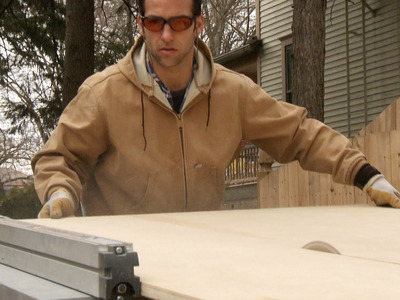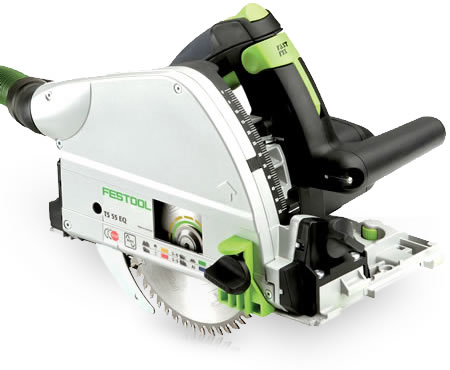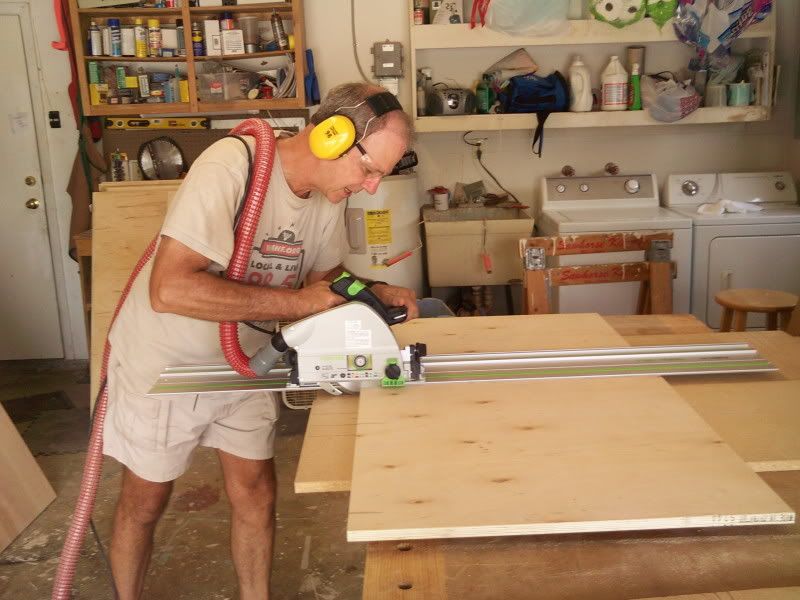There are few things as awkward as wrestling a sheet of 4 foot by 8 foot plywood onto a table saw.
OK, maybe there was the time I asked the cutest and most popular girl in middle school to go to a dance with me. And, after a long pause, she laughed. Loudly. Now, THAT was awkward …
But, think about it. A sheet of 3/4″ ply tips the scales at about 80 pounds, has no easy way to grab and hold and is tough to balance on a table saw’s top while keeping one edge against the rip fence. It’s not easy at all.
That’s why when Paul and I were just starting the cabinet project, we had a brief discussion about getting our hands on one of the ‘new’ track saws to help break the sheets into more manageable sections without the need to break someone’s back or damage their shoulders. Yes, that someone is me…
So, just as the plywood delivery came to the shop and the driver and I were unloading it, Paul walked in with a long, skinny box and a plastic container. Paul had gone out and purchased a Festool TS 55 EQ plunge cut circular saw system for us to use on this project.
Now, Festool isn’t the only company with a dog in this hunt. DeWalt has a model they introduced about two years ago, and Makita also has a track saw system. I can’t really give a comparative review of these other models, but I can tell you that if they work as well at the one we are using, they are worth their weight in gold.
If you wanted to break down some sheets of plywood without one of these track saw systems, you could make yourself a sawboard and use your circular saw on the cut. I’ve used the finest blades possible on my little Black and Decker saw, but still found the splintering on the piece to be unacceptable. This, of course, required me to go from the circular saw cut to the table saw in order to complete the cut. This required that I remember to cut the piece strong and take that second step to get an acceptable edge.
Given the number of cuts on this case, the Festool saved a tremendous amount of time. The cuts came from the saw cleaner than what I could accomplish with my Forrest Woodworker II blade on my table saw. Anything that eliminates a step in the process that doesn’t sacrifice quality is a winner in my book.
The saw is pretty sophisticated. The controls are clearly marked and easy to operate. The saw does plunge to cut and also brings a riving knife down behind the blade. If you have ever cut a board that pinched your saw’s blade during a cut, you know how frustrating and dangerous the situation could be. This plunging action makes inside ‘pocket cuts’ a piece of cake, not a harrowing experience like plunging a traditional circular saw.
The Festool also has an anti-splinter ‘foot’ that presses down on the material just at the front of the blade to prevent splintering along the offcut side.
The track that the saw rides along is also very well thought out. Basically, the saw’s base plate has a square notch worked into its design. This notch mates with a square track that rises from the track to guide the saw. The base of this track has two rubber non-skid strips adhered to it, allowing you to place the guide down and not have to clamp it. However, clamping isn’t the worst idea when cutting a lot of pieces. It just helps to keep the saw track from shifting if you bump into it.
On the edge of this track that guides your cut, there is another anti-splinter device that keeps the keeper half of your board from splintering. Since this is exactly where your saw is cutting, you don’t have to move it into place… it’s always there. The cuts off the track are perfectly straight and beautiful.
The saw also comes with a dust collection port. I was using my shop vac instead of the company’s compatible dust collector, but noticed that the amount of dust generated by the cuts was very small.
The saw’s flexibility in cutting could also lead you to trouble. By not indexing off of a fixed rip fence, you have to be sure you carefully mark the pieces you are cutting. If you mismark and cut on a diagonal, you will get a perfectly straight diagonal. You also have to remember which side is the keeper and ensure you don’t cut it one kerf too narrow by cutting on the wrong side of the line. Just sayin …
Yes, a track saw like the one we picked up is more expensive than just using a sawboard and your circular saw. However, the time you save having to make two separate cuts could really be a difference maker on a large cabinet project. And, if that time savings also happens to lead to better quality cuts, well, sounds like a winner all around.




Great, another “enabler”. 😉 I don’t know why I keep waiting to buy one.
Woah, easy there, Leonard!
Here’s the deal… if you are doing a lot of cabinetry, this is the bomb. If you aren’t… well… I made it a good solid 11 years without one 🙂
Of course, having a saw like this is kind of like owning a pickup truck. Once everyone knows you have it, you’ll be asked to ‘help’ a lot of folks. (Can you help me move? Can you help me build some cabinets? ) 🙂
Glad you joined the club. All my power tools are Festool because of their quality, performance, service and support.
Great company to “partner” with.
Take care,
Bobby Slack.
Festool stuff is really nice but just too much dough.
Guess I’ll have to figure in the time for that extra cut. LOL
Eric –
Believe me – all three track saws – Festool, DeWalt and Makita – cost a pretty penny…
Having just somewhat retired one of my first projects was an entertainment center for a friends daughter. A lot of panel cuts tried on a rented contractors saw. Made it through the project knowing I couldn’t proceed without a decent table saw or track saw system. Holding out for a SawStop hybrid and me thinks the Festool will work for 90% of my work.